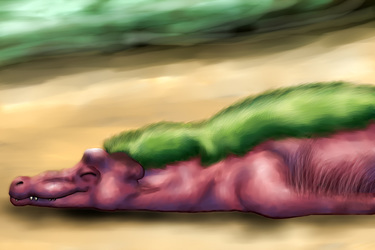Sign In
CloseSix species of freshwater fishes endemic to Mara and the surrounding islands. (I really need to make a map of this place soon... SOON. XD)
Maran Night Perch--A small member of the perch family with large eyes and nocturnal habits. This fish's average length is 3 and a half inches and they rarely weight more than a few ounces. They are equipped with a small venomous spine on their back, but the potency of the venom is quite weak and only prevents larger fish, snakes, and diving birds from attacking them. They mostly feed on small invertebrates attached to rocks and substrate, hunting anything from freshwater sponge to larval snails to dragonfly larva and tadpoles, plucking them off from their perches with their elongated snout. Their only known predators are two species of aquatic frogs endemic to the islands as well.
Frilled Sucker--A small member of the minnow family, the Frilled Sucker is about 3 inches in length and has a nervous disposition. They behave much like more top-swimming minnows or the Darters of the North American continent, feeding on algae and detritus until threatened--fleeing capture in rapid bursts of speed. They are very agile, as their distinctive tall dorsal fin acts as a rudder which gives them the ability to suddenly change course. They belong in the food webs of a great many Maran wildlife species and exist in nearly every small stream or larger river.
Freshwater Pocket Eel--When European explorers from the colonies on the South American continent first arrived on Mara in the late 1600s they were poorly equipped for wilderness survival and rapidly expired their food supply, with near-complete ignorance on how to resupply. The foolhardy activities of these bumbling explorers is the source of this small eel's common name--they would grab them by the fistful out of stagnant pools and cram them in their pockets to carry them back to camp alive. These eels can survive for a long while out of water, but attempting to eat this animal was the downfall of the last few of these guys. Like many eels they rely on a layer of mucus to aid them in squeezing into crevices, burrowing, or hiding in general, but the Freshwater Pocket Eel's mucus has chemical similarities to many species of Tiger salamanders--meaning their mucus layer is highly toxic. The explorers repeatedly displayed their carelessness (and ambivalence to non-human lives and suffering) by simply boiling the eels--poison mucus and all--alive in water. Of course, these repeated doses of toxins caused horrendous health issues, untreatable to the colonial-era medicine, and the settlers ended up paying the price for their actions.
Biologically, these eels are a fascinating branch of eel evolution. While most freshwater eels are migratory and only spawn in the sea, returning to the rivers when adults, these eels are closer related to the saltwater garden eels (and more distantly to snake eels) and stay in the streams their entire lives. They feed mostly on insects but have been known to also take larval crustaceans and fish. They average 6 inches in length but only grow to the thickness of a human's pinkie finger, and can easily survive half an hour out of water.
Striped Sailback Dace--A vibrant member of the barb family, their markings reminded explorers of dace minnows, hence the inaccurate common name. These fish live in large schools which mostly stay under the cover of tree roots, ledges and stones, feeding on tiny phytoplankton and algae. They are hotly protective of their nests, usually stuck to the undersides of branches and roots in a sticky mass, and they often attack much larger animals that approach their eggs too closely. They are highly social and intelligent fishes, communication mostly through posture as with most creatures with sharp vision but no means of producing their own sounds. They can often be seen playing or competing in hierarchical displays in clear deep pools, near the edges of streams.
Freshwater Frogfish--A frogfish species that became landlocked some 200,000 years ago on Mara Isle and has shrunk to a tiny but voracious hunter of only 1 or 2 inches at the most. The smallest member of this family, the Freshwater Frogfish still retains the ability to devour prey nearly as large as itself through a stretchy stomach and a powerful vacuum-suction while biting. Most of the animals they hunt are insects and amphibian larva, though minnows are occasionally caught as well. Their coloration varies based on the time of year--during peak sunlight times their skin changes to green tones, and when the algal blooms die off in the periods of lessened sunlight, their skin turns orange-brown, brown and black, or pale grey (depending on what kind of mud or sand they stay around).
Water-Puppy--The Water-Puppy is a tiny plecostamus species with a flattened body and attractive blue-green, black, and yellowish blotch markings. They feed mostly on algae and eggs of insects and other fishes, and detect threats through the extra-sensitive spines and whiskers from their backs. They are unusual in that they often crawl along the bottom with their four highly mobile fins rather than swimming, and they often crawl right out of the water when it dries out too much or there is not enough edible material in it. They can travel a full night over moist ground and several hours in dry conditions. Residents of the two human-inhabited islands in the chain often keep these plecos as pets in small aquariums filled only halfway, allowing the plecos to climb on branches, weeds, and stones. Exporting these fish is not illegal, but is strictly monitored and owning one outside of the island territories requires a specialized permit.
More FEESH. :D
Submission Information
- Views:
- 1508
- Comments:
- 0
- Favorites:
- 1
- Rating:
- General
- Category:
- Visual / Digital




